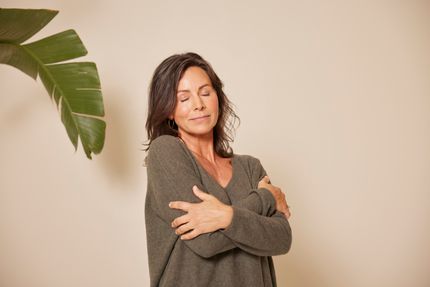Bursitis and menopause
Bursitis (an inflammatory condition of a sac, or bursa, surrounding the joints) occurs when a bursa becomes inflamed due to overuse or injury. It is a classic injury among athletes such as runners. Menopause can contribute indirectly to bursitis. This has everything to do with the role that oestrogen plays in keeping joints, tendons and bones healthy. The good news is there are things you can do about it.

Since my periods stopped three years ago, I’ve been struggling with bursitis. It’s painful and affecting my range of motion. Does it have anything to do with menopause? - Paula (age 51)

In general, women have a lower risk of bone issues than men. This can be due to certain types of work or sports activities. However, in postmenopause, women have much more bone-related problems than before. Research indicates that 20 percent of bone loss occurs during menopause.
The same applies to tendons, joints, and muscles: most women start to experience problems in the postmenopausal stage of their lives. Bursitis of the hip, shoulder, elbow and knee is also more common in postmenopausal women.
What is happening in your body?
The most common symptoms that women going through menopause report experiencing are hot flashes, sleep problems and mood swings. But there are also lesser well-known symptoms of menopause, such as bursitis.
Bursae are a soft, fluid-filled pads or sacs between the tendons, joints and bones, and at the ends of bones. They are located around large joints like the hip, shoulder and elbow to facilitate movement. The main function of bursae is to reduce friction and provide shock absorption (e.g., impact on the knee from running).
Oestrogen plays a key role in keeping the bursae supple and healthy, just like it helps protect the health of your joints, muscles and bones. During perimenopause and especially postmenopause, oestrogen drops and then reaches a permanently low level. As a result, your bones become weaker and tendons less flexible.
In addition, as your oestrogen levels drop, your collagen production decreases along with it. Collagen is the primary building block of your body's skin, muscles, bones, tendons and ligaments. Oestrogen ensures that your body gets the right amount of collagen to keep it moving in a supple way.
Low levels of oestrogen can make your body more susceptible to developing muscle, bone, tendon and joint problems. Your body’s load capacity (i.e., the amount of stress that your body is able to tolerate) will decrease and overstressing is more likely to cause inflammation.
Other causes
Other common causes of bursitis include injury and overuse. Infection may also cause it. Bursitis is also associated with other conditions, such as arthritis, joint problems, diabetes and thyroid disease.
What can you do?
Lifestyle adjustments such as exercise and stress management help maintain the health of your bones, tendons and muscles.
- Hormone therapy can help to counteract the impact of low oestrogen on muscles, tendons, joints and bones during postmenopause.
- Exercise. High-impact sports should be avoided because of injury risk. Focus on low-impact activities such as walking, yoga, strength training, Pilates or swimming. These sports help build muscle and improve muscle function, reducing strain on your joints.
- Nutrition. Eat lots of fruit and vegetables that are rich in antioxidants (blueberries, spinach, nuts, seeds). Antioxidants help protect the body from the damaging effects of inflammation.
- Supplements. Dietary supplements can help with deficiencies. For example, omega-3 has anti-inflammatory properties and provides the body with fatty acids it isn’t able to produce on its own. A multivitamin complex is also a safe and effective way to fill nutritional gaps.
- Relaxation. Rest is the best medicine for bursitis. When you get enough rest, your body naturally reduces cortisol levels. This helps keep problems like hip bursitis at bay.
- Posture. Improve your posture. Sit up straight and do not slump to one side when working. Get up from your desk and move around regularly throughout the day. Make sure you have a good posture when you exercise or sit on the sofa.

Medication for bursitis
Bursitis is typically treated with rest and non-steroidal anti-inflammatory drugs (NSAIDs) to relieve pain and reduce inflammation in hips, shoulders, elbows or knees. This helps to make movement easier and less painful.

What treatments can help?
A healthy diet and exercise is the key to maintaining a healthy body. Looking after your health is also the basis for getting through menopause as smoothly as possible. However, sometimes a healthy lifestyle isn't enough. In some cases, pain medication may be necessary to ease the discomfort.
Anti-inflammatory painkillers for bursitis
Do you have pain in your hips, shoulders, elbows or knees due to bursitis? Then non-steroidal anti-inflammatory drugs (NSAIDs) like Etoricoxib or Meloxicam could be an option. These medicines not only alleviate pain, but also reduce inflammation.

Ice and painkillers provide immediate relief. I also try to keep moving, without overdoing it. - Lea (age 58)

Can hormone therapy help?
Hormone replacement therapy (HRT) replaces lost hormones (oestrogen and progesterone) to counteract the effects of menopause. HRT is used to alleviate symptoms of menopause such as hot flashes and mood swings. Do you also have other symptoms besides bursitis? Then hormone therapy might be an option for you.
Sources
- Jane A. Cauley. (2015). Estrogen and bone health in men and women. https://www.sciencedirect.com
- D.R. Leblanc, M. Schneider, P. Angele, G. Vollmer, D. Docheva. (2017). The effect of estrogen on tendon and ligament metabolism and function.
- The Johns Hopkins University. Bursitis. https://www.hopkinsmedicine.org/health/conditions-and-diseases/bursitis
- Chidi-Ogbolu N, Baar K. (2019). Effect of Estrogen on Musculoskeletal Performance and Injury Risk. PMID: 30697162.
- Harding AT, Heaton NS. (2022). The Impact of Estrogens and Their Receptors on Immunity and Inflammation during Infection. PMID: 35205657.
- Hansen M, Skovgaard D, Reitelseder S, Holm L, Langbjerg H, Kjaer M. (2012). Effects of estrogen replacement and lower androgen status on skeletal muscle collagen and myofibrillar protein synthesis in postmenopausal women. PMID: 22389460.
- Sipilä S, Taaffe DR, Cheng S, Puolakka J, Toivanen J, Suominen H. (2001). Effects of hormone replacement therapy and high-impact physical exercise on skeletal muscle in post-menopausal women: a randomized placebo-controlled study. PMID: 11473488.
Your path to a smooth menopause starts here
Get the tools you need to navigate menopause with more ease and to educate yourself about your body. With tips and insights from experts, and relatable stories of women just like you. Press play, not pause.
Tips and advice


FAQ
What type of joint pain is common during the menopausal years?
Decreasing oestrogen levels during perimenopause contribute to loss of bone density, increasing the risk of osteoporosis. This can cause joint problems such as pain, irritation or inflammation. The rubbing of bone against bone is the source of these symptoms. Joints that are most frequently affected are the small joints of the hands, wrists and fingers, though other joints in the body, such as the knees, neck, lower back and hips may experience pain as well. The more pressure on the joints, the more pain you may have. You may also experience stiffness, muscle weakness and lack of flexibility. If the joints are red, swollen, painful or warm, this is a sign of inflammation. More about painful joints.












